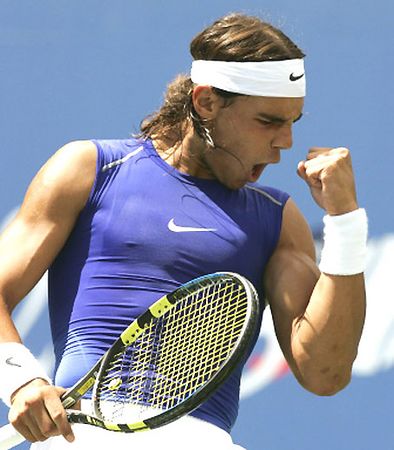
|

Spanish export is hot commodity
Nadal's blend of shotmaking and charismatic on-court personality have created a buzz for the 19-year-old phenom who has unlimited upside
By Johnette Howard, Staff Writer
September 4, 2024
Rafael Nadal is more than just 19 and already a haymaker-throwing French Open champion. He has a power-charged game, a baby bull's build, and a transfixing on-court personality. With Andy Roddick already gone from this year's U.S. Open, Nadal is celebrated because he's exactly what men's tennis has been keening for: An antidote to the predictions that Roger Federer's stay atop men's tennis is destined to be long and uninterrupted and aesthetically nice, thanks, but nothing that's likely to move the needle on the excitement register.
Enter Nadal. In the past five months, the Spanish teenager has risen from No. 46 to second in the world, and put himself in position to slingshot by Federer for No. 1 if he wins this tournament. Already, he's eclipsed the 23-year-old Roddick as Federer's greatest potential foil and tennis' favorite pin-up boy. He meets James Blake Saturday in a third-round match.
Nadal strides out for matches, racket already in hand, with a pirate's bandana around his shoulder-length black hair, a torso-hugging sleeveless shirt that shows off his deeply tanned arms and six-pack stomach, and matador pants that slyly hint that he comes from Spain.
His looks and effect on crowds are impossible to not comment upon. If tennis had a Cecil B. DeMille right now, Nadal would be cast opposite 18-year-old women's star Maria Sharapova as the sport's dream couple, the It Boy and It Girl whom the paparazzi snap dancing in some Ibiza disco or breezing into some Cannes movie premiere, or hanging out around the roulette wheel in Monte Carlo.
Except this is where Nadal, at least right now, flips the script.
He still lives at home on the Spanish island of Mallorca with his extended family - his parents, grandparents and uncle Toni, his coach since childhood - in a five-story apartment building they share in Manacor, a town of about 30,000 people.
Rafa, as he is affectionately called at home, doesn't even have a driver's license. Though he turned pro at 15, not long after defeating former Wimbledon champ Pat Cash in an exhibition match, Nadal's family insisted that he stay in regular high school during his breaks from the tour, and forego an offer to move to a Barcelona academy and have his training subsidized by the Spanish tennis federation.
Both choices - skipping junior tennis completely, and staying home at his modest five-court club to train on clay - were highly unorthodox. Yet Nadal has won like crazy anyway.
He seized 37 of the first 40 pro matches he played on the satellite tour, tennis' equivalent of baseball's Triple A circuit. The excitement about him here is astonishing considering he won his first main tour hardcourt title just three weeks ago, in Montreal. But it's not misplaced. His uncle believes had Rafael not been hurt for long stretches in 2003 and 2004, the tear he embarked on this year - roaring to the final of the NASDAQ tournament in Miami this February opposite Federer, then winning three straight claycourt tournaments before seizing the French Open - would have happened even sooner.
But it was the French Open win - and most especially, Nadal's victory over Federer in the semifinals there after falling just two points shy of beating him at NASDAQ - that has worked an alchemy on Nadal's career and made him an international conversation piece.
A steady stream of tennis pundits and stars have been asked to rate him or explain him since that win. And in the end, after remarking on the particulars of his game, most come to the same conclusion that Boris Becker, who knows something about being a teenage wunderkind, expressed this year at Wimbledon.
"He is by far the best player at 19 of his generation," Becker told The Independent of Britain. "If I look back, Stefan Edberg was very good. John McEnroe was good. Federer was good ... I was not bad. But Nadal is among that group. When you win a Grand Slam at 19 years old, it puts you there automatically. He's very good for tennis."
On an ESPN conference call, commentator McEnroe agreed. "Not since the days of Boris Becker have I seen such intimidation on a tennis court," McEnroe said. "His physicality can frighten opponents into submission almost without a stroke being played. It's the beauty of youth. He's fearless and he loves to compete."
The other thing about Nadal that's notable is when tennis pundits are asked whom he reminds them of, the answer is usually "Nobody." Like a lot of eventual greats, Nadal is an original. He has the relentlessness that all great players reared on clay courts have had.
But he combines it with the footspeed and the sort of power, especially on his forehand side, that will allow his game to translate to any surface, even grass, especially once his ongoing work to improve his serve takes hold. The fact that he's lefthanded presents an added challenge.
Already, Nadal can think the game, too.
Asked after the French Open how he was able to remain so poised given the pressure and the occasion, Nadal said, "The only way of finding a solution is to fight back, to move, to run, and to control that pressure."
In an era where sportspeople try so hard to have personality - "Sometimes too hard," U.S. Davis Cup captain Patrick McEnroe said - Nadal has substance as well as fizz. Before Wimbledon, the sloganeers at Nike trotted him out for a get-to-know Nadal media day in Madrid.
And a banner on the stage that day should prove to be prescient. It read: "Tennis has changed - get used to it."
**Please do not reproduce without giving credit to the original source and VamosRafael.com.**
Return to VamosRafael.com.
Return to VamosRafael.com Articles.


